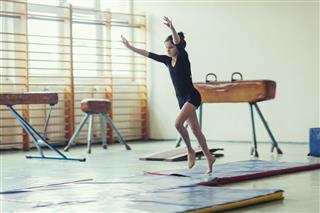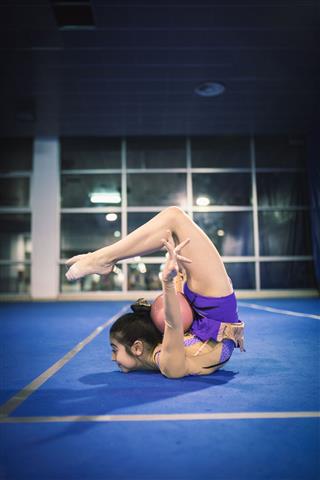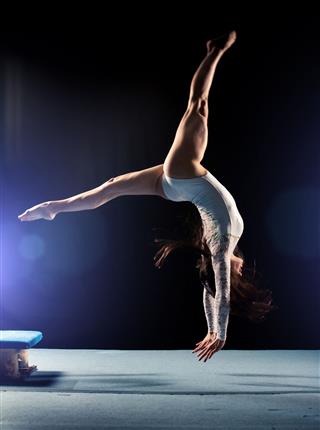
Call it an art or a sport, gymnastics is something that needs endless hours of dedicated practice to be perfected. It is a combination of control of the mind and body, and a beautiful sight to behold when performed by a trained individual.
Kerri Strug, an American gymnast, is best remembered for her gold medal winning vault, that she performed despite having a serious ankle injury.
The first gymnast to ever record a perfect score of 10 in modern Olympic history was Nadia Comăneci from Romania, at the 1976 Olympics held in Montreal. She achieved this feat while performing on the uneven bars, something which was thought impossible till then. One can imagine the training and hard work that she and her team put in to scale such heights.
A gymnast, by nature, is supposed to be very flexible and agile, and can carry out seemingly impossible sequences of moves using a variety of props. For a person who is interested in learning gymnastic moves, it is imperative to do so under the tutelage of an experienced instructor. Watching the moves on television and reading about them over the Internet will be helpful only as a reference before beginning the training. These moves require tremendous technique and a lot of training, and it is always better to start learning them at a young age. The earliest age to start gymnastics training is 18 months. Following is an illustrative list of some floor, beam, vault and bar gymnastic moves, take a look.
Floor and Beam Gymnastic Moves
Back Handspring

A backward flip of the body, where the gymnast lands on hands, and the legs then follow in the same direction as a pair. After the flip is done, the gymnast returns to a standing position.
Front Handspring

It is similar to a back handspring, the only difference being that the gymnast moves forward. For getting a perfect front handspring or even a back handspring, for that matter, one needs to have strong upper body and should be well acquainted with a handstand and a front walkover. To get the momentum for the move, the gymnast runs a few steps, puts the dominant foot forward while the hands are up straight, tight to the ears and eyes looking in front. The leg that is put forward is also straight and tight and it is then placed flat on the ground. Further, the hands are placed on the ground a little away from the front foot and the leg behind is kicked off of the floor. Then the front leg is pushed off with great force in order to land in the standing position.
Backward Somersault

A backward rolling movement on the floor, where the knees are tucked in as far as possible. The move is also commonly performed in the sport of swimming.
Forward Somersault

A forward flip movement on the floor, where the knees are tucked in as far as possible. It can also be performed with the legs in pike or layout position and is also called front somersault.
Cartwheel

A basic sideways move where the hands reach the floor one at a time towards the side, and the legs also follow in a similar manner. While performing a cartwheel, the gymnast does a full rotation from standing position to an inverted one and again back to the standing position. The visual gives a feel of a cartwheel and hence it is named as a cartwheel gymnastic move.
Aerial Cartwheel

A gymnast does a cartwheel without the hands touching the floor. It differs from a cartwheel wherein, hands touch the ground for support. It is also known as side flip, side aerials, no-hands cartwheel or just aerials.
Aerial Walkover

It is an acrobatic move in which the gymnast executes a complete revolution of the body without touching the ground. It is also known as front aerial, front-aerial walkover, etc.
Round Off

It begins from the standing position with arms in upward direction. Then the hands are placed on the floor to get in the cartwheel position. However, the arms must reach forward instead of the sides to get a correct round off. The gymnast should not leap in a round off and the second foot should leave the floor only when the first hand touches the floor. It is also important that the head is kept in throughout the move to achieve an over the top effect and not the round off around the side.
Straight Jump

The move begins with a standing position with one leg in front of the other. Then the knees are slightly bent and a push is generated from toes to execute a jump straight up in the air. The legs are kept straight during the flight and when landing, the heels are lowered to the beam with the knees slightly bent. The beauty of this move lies in the upright posture of the gymnast with shoulders and hips squared and the chest up throughout the skill.
Scissors Leap

It is the leap in which the legs exchange their positions while airborne, executing a split with both the legs. It also has other names like a switch leap or a switch split leap.
Split Leap

The gymnast stands in the position of high toes. Then taking a run up of 2-3 steps, he/she takes off from one foot in forward direction with one leg stretched horizontally in the front and the other at the back. Then landing on the leading leg, touching the ball of the foot, he/she steps through with the other leg. Turning the leading foot slightly outwards will help controlled landing.
Cross Handstand

In this move the gymnast places hands close to each other over the width of the beam. His/her stomach is parallel to the length of the beam and then the legs go up closed in the handstand position.
Back Walkover

It is a move in which the gymnast rests hands on the floor or a beam, and legs come over the head and make a kicking motion in a reverse or backward direction.
Front Walkover

When a move is made forward from a front split handstand position, it is called front walkover. In this move both the feet are brought down, one after the other, towards the back. It differs from a front handspring because the legs in this type move one after the other instead of pairs and in a smoother way.
Vault Gymnastic Moves
Front Handspring

It is similar to a floor handspring, only difference being the use of a springboard and a vault. The gymnast runs towards the vaulting table and takes a jump from the springboard on to the table followed by a rotational movement in the air and back to the standing position on the floor.
Yurchenko

It is a move named after a famous gymnast, Natalia Yurchenko. A unique characteristic of Yurchenko is that it is a combination of several moves performed in one event. The move begins with a round off on to the springboard, a back handspring on the vault followed by a backflip off the vault on to the floor.
Tsukahara

It is a vault maneuver named after a Japanese gymnast Mitsuo Tsukahara. Sometimes, it’s also called a Moon Somersault or a Moon Salto. The gymnast takes a half turn on to the vault and goes off the vault with a backflip. In many nations, a full-twisting double salto tumble or a dismount is often referred to as tsukahara.
Uneven/Parallel/High Bar Gymnastic Moves
Hip Circle

It is a move in which the gymnast circles the parallel bars or the uneven bars, while the hips are touching the bars. This move can be performed in two ways, viz., front hip circle and a back hip circle. When the hips do not touch the bars while making a hip circle, it is known as a free hip circle.
Flyaway

It is a combination of a forward swing and release from a high bar ending with a backflip off of the bar. It is a kind of dismount that can be performed from a high bar, uneven bars or rings. Professional gymnasts present difficult variations, which include multiple twists and flips.
Kip

It is a move in which the gymnast moves from a gliding or hanging position on the bar to a front support position. He/she first brings the legs to the bar, then the hips and pulls herself till the front support position is attained.
It is important to note that this is not a complete list of gymnastic moves since there are several combinations of body forms, body positions and apparatuses that contribute to creating a move. Furthermore, newer moves are getting evolved day by day increasing the difficulty level for the gymnasts.



















